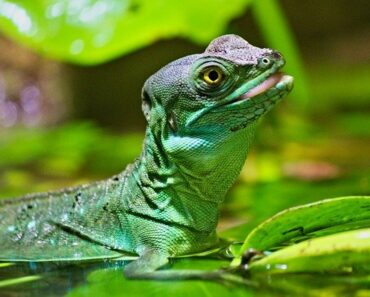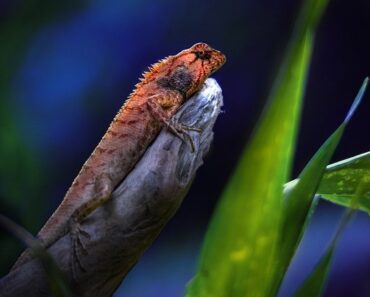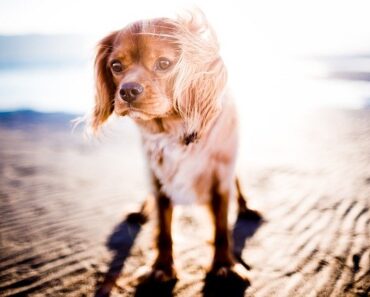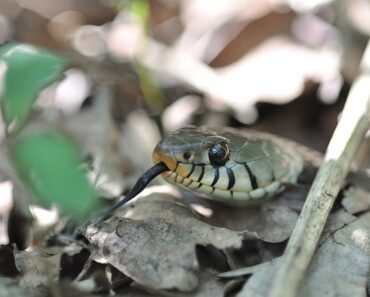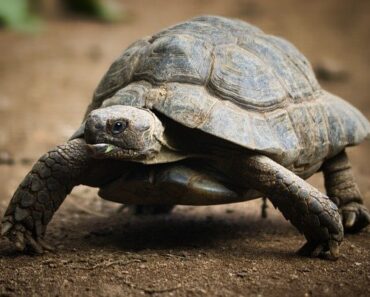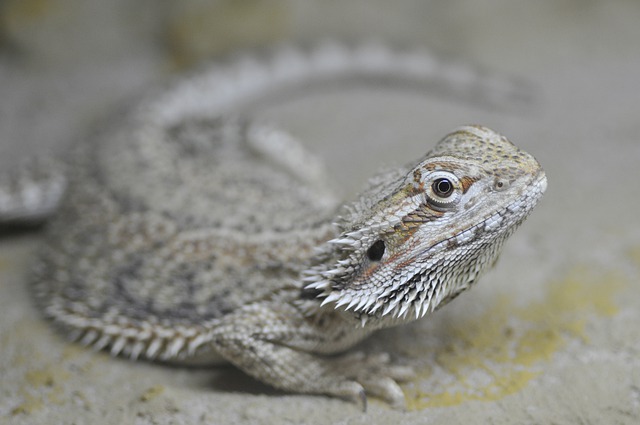
His long tail measures half his size. He can live more than 8 years.
The pogona is also called Bearded Dragon. It is an oviparous animal that can live very well in a terrarium.
The life of the pogona in a terrarium
The pogona can live alone, as a couple or with three individuals. It is a diurnal animal that normally lives in a desert environment. It feeds mainly on invertebrates and plants and is omnivorous. For them to live in a terrarium, it is therefore necessary to reconstitute their natural environment and provide them with the necessary care and equipment.
The choice of the terrarium
A terrarium can be made to measure or purchased in a store. The size depends on the number of pogonas and their age. Youngsters will need less space than adults.
For a terrarium, count between 200 and 400 €, depending on its size.
The hygrometry of the terrarium should be between 20 and 30%.
The size of the terrarium
For a young pogona, the terrarium should measure at least 60x60x60 cm.
For 2 or 3 youngsters, the terrarium should measure at least 80x40x40 cm.
For an adult, the terrarium should measure 120x60x60 cm.
For 2 or 3 adults, it should measure at least 150x60x60 cm.
But if the terrarium is purchased for a young person, it will have to be changed once he has reached adulthood. It is therefore better to plan a large one right away.
Terrarium decoration
Pogonas need warmth, they are cold-blooded animals. It will be necessary to recreate their desert environment. For a good balance in the terrarium, it is advisable to create a corner with the necessary material and leave the rest of the terrarium empty, like the desert.
The pogona likes to have hiding places in its environment, corners to isolate itself. It is also necessary to plan to install branches in its terrarium, but treated branches, not dangerous.
A bowl of water and a bowl of food are necessary, knowing that the bowl of water must be large enough to be used as a bath.
Lamps and heating
The terrarium needs a warm side and a cooler side. For heating, several types of heat sources can be used: heat lamps, heating cables or heating mats. To use a heat lamp, stones have to be placed underneath, to keep and diffuse the heat.
To manage the heating, a thermostat is essential :
- The warm side of the terrarium should be at a temperature of 30 to 35 degrees during the day and 20 to 24 degrees at night.
- The cold side of the terrarium should be at a temperature of 25 to 30 degrees during the day and 22 to 26 degrees at night.
A neon light must be installed in the vivarium for lighting. This neon must be changed twice a year, it must be UVA and UVB 10.
The terrarium must be illuminated 10 to 14 hours per day in summer, 10 hours in spring and fall and 8 hours in winter. A red light at night is not recommended.
The rhythm of life of the pogona
As the year progresses, the pace of life changes. For this reason, the lighting duration evolves. The pogona hibernates in winter and mates in spring.
A female pogona has a gestation period of 4 weeks. She can lay between 20 and 40 eggs, every 2 months on average.
Choosing the right substrate
Depending on the age of the pogona, the substrate varies.
For young pogonas, wood chips are recommended. This material is well adapted to their age and allows the crickets to hide, forcing the pogonas to hunt.
For adults, special reptile sand is more suitable, it contains calcium and makes cleaning easier.
For all pogonas, both babies and adults, plant litter can be used. It will cost less than special reptile sand and is easy to maintain, but less suitable for this species, as it does not contain calcium for adults and does not allow the crickets to hide for the young. It is more suitable as a troubleshooting choice.
Terrarium hygiene
For good hygiene, remove the faeces from the pogonas every day and change the water in the bowl/bath.
The terrarium should be cleaned completely every three months and the entire substrate should be changed.
Feeding the pogona
Contrary to the mores, the pogona does not only feed on insects. It is really greedy and needs a varied diet.
The diet varies according to the age of the pogona.
Before 6 months, it feeds on 80% insects and 20% fresh fruit and vegetables cut into pieces. A complement of vitamins and calcium is advised.
After 6 months and all its life, it will feed on 20% insects and 80% of fruits and vegetables cut in pieces.
The change of food rhythm must be done in a progressive way towards its 6 months.
From the age of 1 year, it is possible to supplement the diet with mice, to be given from time to time.

